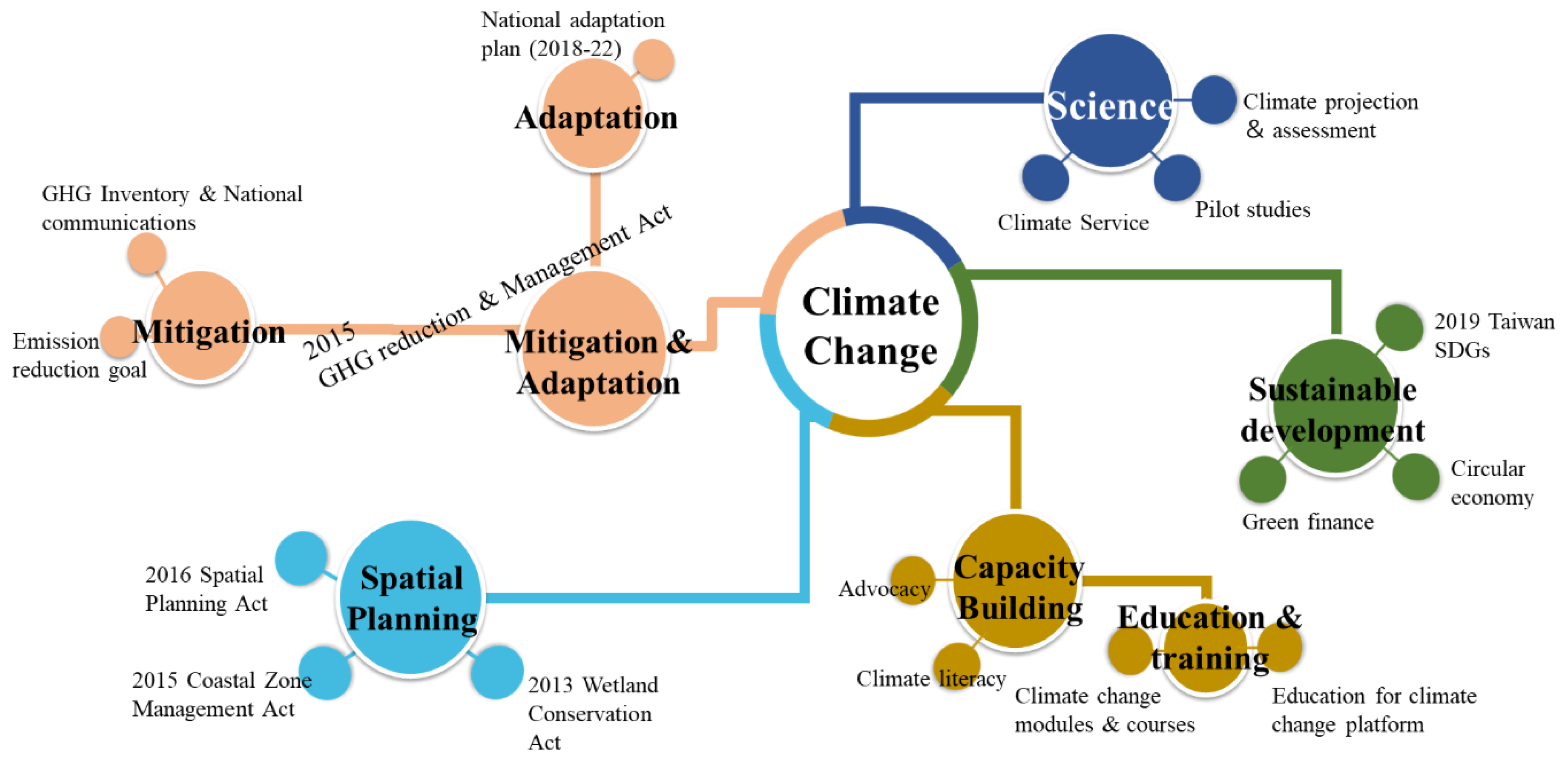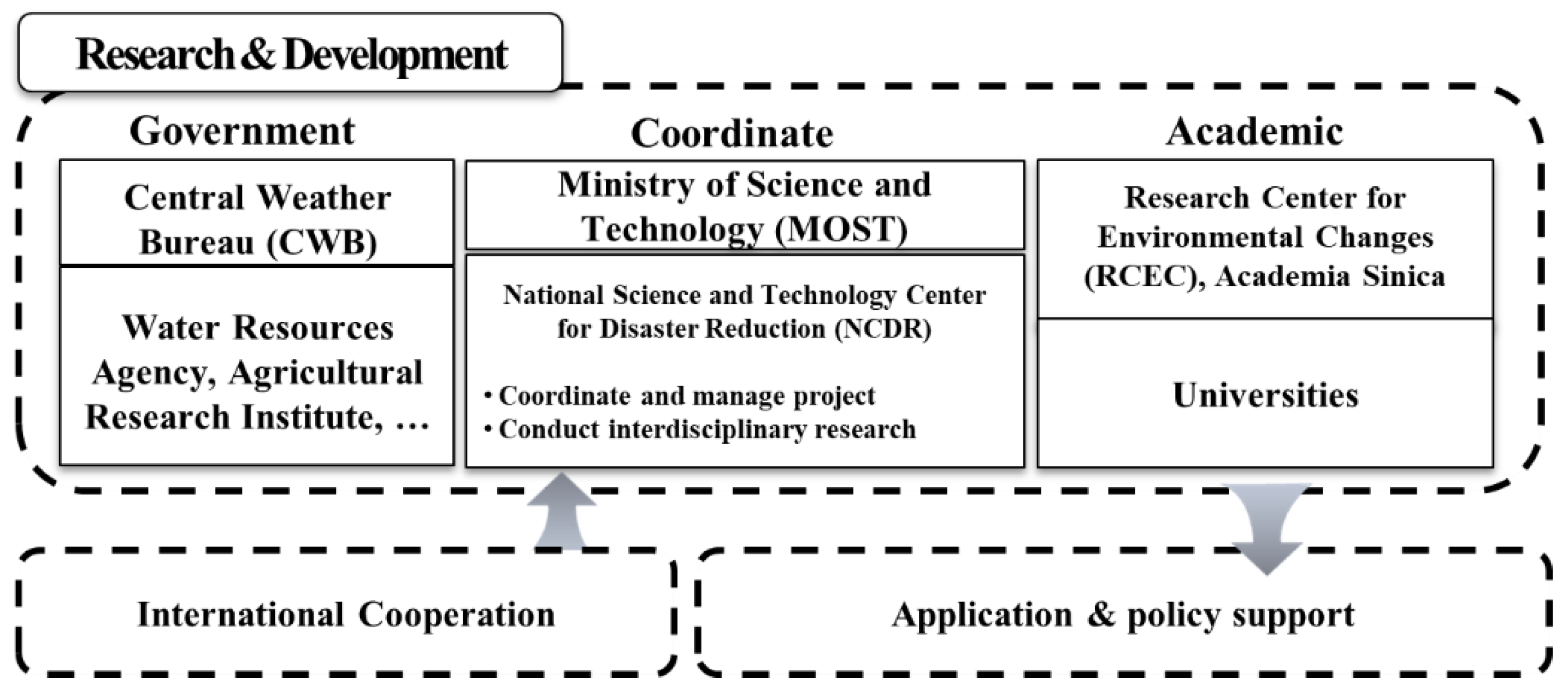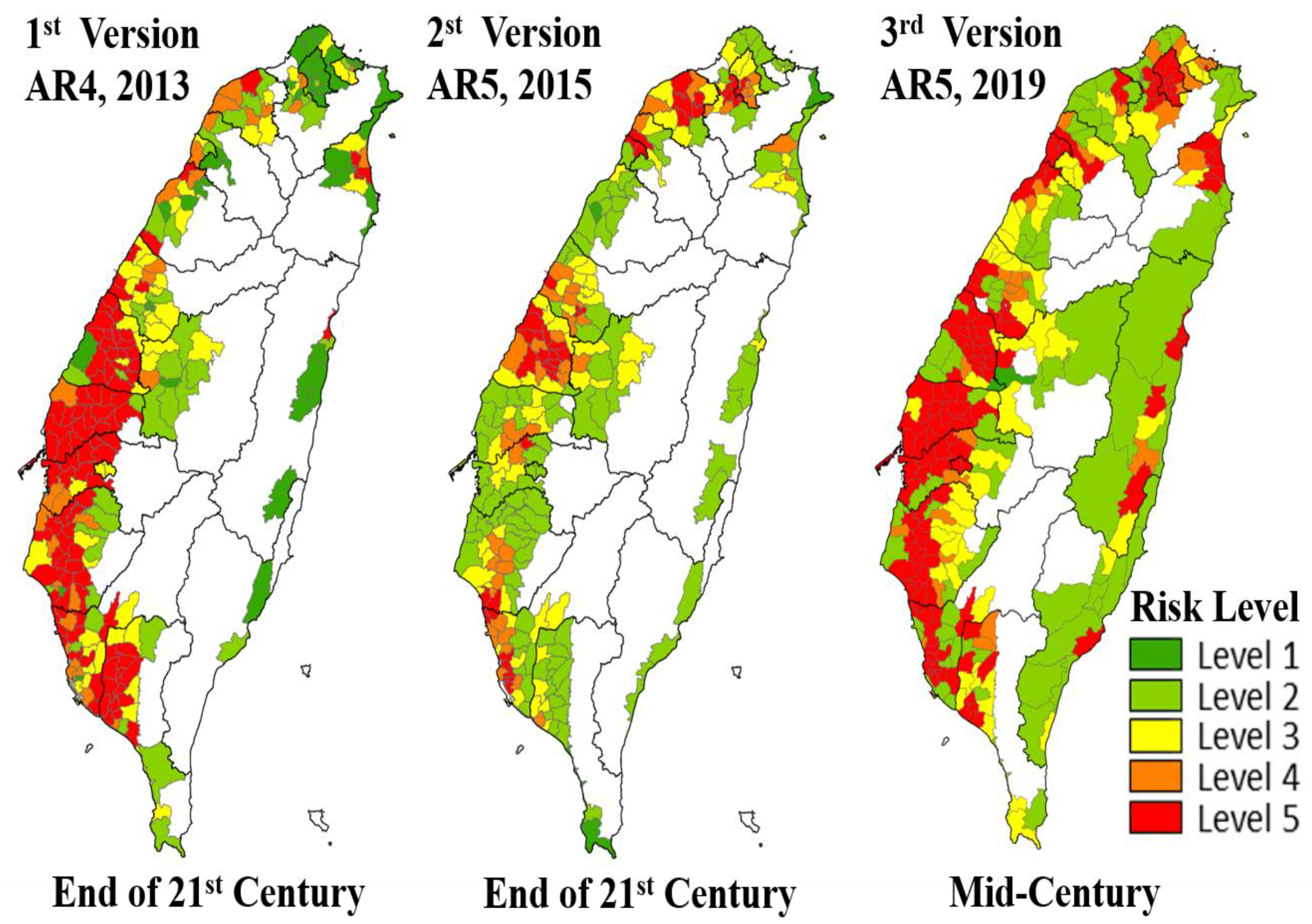The Taiwan Climate Change Projection Information and Adaptation Knowledge Platform: A Decade of Climate Research
Abstract
:1. Introduction
2. Integration and Development of Climate Data
2.1. Integration of Observation Data
2.2. Development of Climate Projection
3. The Evolution of TCCIP Projects
4. Application and Promotion of Climate Data
4.1. Adaptation Research, Policy Support and Advocacy
- Flood disasters at the Choshui River catchment may occur in a shorter time duration, and river catchment will face more severe degradation [56].
- The overflow risk of the Tsengwen River under extreme events was initially studied [63]. This was extended into a more comprehensive impact assessment of the surrounding regions [64] and coupled with assessment tools to conclude that approximately 7 billion NTD of loss may be reduced by implementing adaptation measures [65].
4.2. Application of Climate Data: The Risk Maps
4.3. Comparison with Existing Studies
5. Conclusions
Author Contributions
Funding
Institutional Review Board Statement
Informed Consent Statement
Conflicts of Interest
References
- Hung, C.-W. A 300-Year Typhoon Record in Taiwan and the Relationship with Solar Activity. Terr. Atmos. Ocean. Sci. 2013, 24, 737. [Google Scholar] [CrossRef] [Green Version]
- National Development Council. Adaptation Strategy to Climate Change in Taiwan; National Development Council, Taiwan: Taipei, Taiwan, 2012.
- National Development Council. National Climate Change Adaptation Action Plan (2013–2017); National Development Council, Taiwan: Taipei, Taiwan, 2014.
- Environmental Protection Administration. Greenhouse Gas Reduction and Management Act 2015; Environmental Protection Administration, E.Y.: Taipei, Taiwan, 2015.
- Environmental Protection Administration. National Climate Change Adaptation Action Plan (2018–2022); Environmental Protection Administration, E.Y.: Taipei, Taiwan, 2019.
- Ministry of Interior. Wetland Conservation Act; Ministry of Interior, Taiwan: Taipei, Taiwan, 2013.
- Ministry of Interior. Coastal Zone Management Act; Ministry of Interior, Taiwan: Taipei, Taiwan, 2015.
- Ministry of Interior. Spatial Planning Act; Ministry of Interior, Taiwan: Taipei, Taiwan, 2016.
- Environmental Protection Administration. Taiwan Sustainable Development Goals; Environmental Protection Administration, E.Y.: Taipei, Taiwan, 2019.
- Climate Change Education. Available online: https://climatechange.tw/en-us/ (accessed on 15 April 2021).
- Glasbey, C.A.; Nevison, I.M. Rainfall Modelling Using a Latent Gaussian Variable. In Modelling Longitudinal and Spatially Correlated Data; Springer: New York, NY, USA, 1997; pp. 233–242. [Google Scholar]
- Simolo, C.; Brunetti, M.; Maugeri, M.; Nanni, T. Improving estimation of missing values in daily precipitation series by a probability density function-preserving approach. Int. J. Clim. 2010, 30, 1564–1576. [Google Scholar] [CrossRef]
- Gobiet, A.; Suklitsch, M.; Heinrich, G. The effect of empirical-statistical correction of intensity-dependent model errors on the temperature climate change signal. Hydrol. Earth Syst. Sci. 2015, 19, 4055–4066. [Google Scholar] [CrossRef] [Green Version]
- Maurer, E.P. Uncertainty in hydrologic impacts of climate change in the Sierra Nevada, California, under two emissions scenarios. Clim. Chang. 2007, 82, 309–325. [Google Scholar] [CrossRef] [Green Version]
- Wood, A.; Maurer, E.; Kumar, A.; Lettenmaier, D.P. Long-range experimental hydrologic forecasting for the eastern United States. J. Geophys. Res. Earth Surf. 2002, 107, ACL 6-1–ACL 6-15. [Google Scholar] [CrossRef]
- Wood, A.; Leung, L.R.; Sridhar, V.; Lettenmaier, D.P. Hydrologic Implications of Dynamical and Statistical Approaches to Downscaling Climate Model Outputs. Clim. Chang. 2004, 62, 189–216. [Google Scholar] [CrossRef]
- IPCC. Climate Change 2007: Synthesis Report. Contribution of Working Groups I, II and III to the Fourth Assessment Report of the Intergovernmental Panel on Climate Change; Core Writing Team, Pachauri, R.K., Reisinger, A., Eds.; IPCC: Geneva, Switzerland, 2007; p. 104. [Google Scholar]
- Mizuta, R.; Yoshimura, H.; Murakami, H.; Matsueda, M.; Endo, H.; Ose, T.; Kamiguchi, K.; Hosaka, M.; Sugi, M.; Yukimoto, S.; et al. Climate Simulations Using MRI-AGCM3.2 with 20-km Grid. J. Meteorol. Soc. Jpn. 2012, 90, 233–258. [Google Scholar] [CrossRef] [Green Version]
- Skamarock, W.C.; Klemp, J.B.; Dudhia, J.; Gill, D.O.; Barker, D.M.; Duda, M.G.; Huang, X.Y.; Wang, W.; Powers, J.G. A Description of the Advanced Research WRF Version 3; NCAR Technical Note, NCAR/TN-475+STR; Mesoscale and Microscale Meteorology Division, National Center for Atmospheric Research: Boulder, CO, USA, 2008; Available online: https://opensky.ucar.edu/islandora/object/technotes:500 (accessed on 15 April 2021).
- IPCC. Climate Change 2014: Synthesis Report. Contribution of Working Groups I, II and III to the Fifth Assessment Report of the Intergovernmental Panel on Climate Change; Core Writing Team, Pachauri, R.K., Meyer, L.A., Eds.; IPCC: Geneva, Switzerland, 2014; p. 151. [Google Scholar]
- Chen, J.-H.; Lin, S.-J. Seasonal Predictions of Tropical Cyclones Using a 25-km-Resolution General Circulation Model. J. Clim. 2013, 26, 380–398. [Google Scholar] [CrossRef]
- Hong, N.-M.; Lee, T.-Y.; Chen, Y.-J. Daily weather generator with drought properties by copulas and standardized precipitation indices. Environ. Monit. Assess. 2016, 188, 383. [Google Scholar] [CrossRef] [PubMed]
- Liu, H.-W.; Yu, J.-Y.; Chen, C.-A. Changes of tropical precipitation and convective structure under global warming projected by CMIP5 model simulations. Terr. Atmos. Ocean. Sci. 2018, 29, 429–440. [Google Scholar] [CrossRef] [Green Version]
- Lin, C.-Y.; Chua, Y.-J.; Sheng, Y.-F.; Hsu, H.-H.; Cheng, C.-T.; Lin, Y.-Y. Altitudinal and latitudinal dependence of future warming in Taiwan simulated by WRF nested with ECHAM5/MPIOM. Int. J. Climatol. 2015, 35, 1800–1809. [Google Scholar] [CrossRef]
- Tsou, C.-H.; Huang, P.-Y.; Tu, C.-Y.; Chen, C.-T.; Tzeng, T.-P.; Cheng, C.-T. Present Simulation and Future Typhoon Activity Projection over Western North Pacific and Taiwan/East Coast of China in 20-km HiRAM Climate Model. Terr. Atmos. Ocean. Sci. 2016, 27, 687–703. [Google Scholar] [CrossRef] [Green Version]
- Su, Y.-F.; Cheng, C.-T.; Liou, J.-J.; Chen, Y.-M.; Kitoh, A. Bias Correction of MRI-WRF Dynamic Downscaling Datasets. Terr. Atmos. Ocean. Sci. 2016, 27, 649–657. [Google Scholar] [CrossRef] [Green Version]
- Huang, W.; Chang, Y.; Hsu, H.; Cheng, C.; Tu, C. Dynamical downscaling simulation and future projection of summer rainfall in Taiwan: Contributions from different types of rain events. J. Geophys. Res. Atmos. 2016, 121, 13973–13988. [Google Scholar] [CrossRef]
- Huang, W.-R.; Chang, Y.-H.; Cheng, C.-T.; Hsu, H.-H.; Tu, C.-Y.; Kitoh, A. Summer Convective Afternoon Rainfall Simulation and Projection Using WRF Driven by Global Climate Model. Part I: Over Taiwan. Terr. Atmos. Ocean. Sci. 2016, 27, 659–671. [Google Scholar] [CrossRef] [Green Version]
- Huang, W.-R.; Chang, Y.-H.; Hsu, H.-H.; Cheng, C.-T.; Tu, C.-Y. Summer convective afternoon rainfall simulation and projection using WRF driven by global climate model. Part II: Over South China and Luzon. Terr. Atmos. Ocean. Sci. 2016, 27, 673–685. [Google Scholar] [CrossRef] [Green Version]
- Kimura, N.; Chiang, S.; Wei, H.-P.; Su, Y.-F.; Chu, J.-L.; Cheng, C.-T.; Liou, J.-J.; Chen, Y.-M.; Lin, L.-Y. Tsengwen Reservoir Watershed Hydrological Flood Simulation under Global Climate Change Using the 20 km Mesh Meteorological Research Institute Atmospheric General Circulation Model (MRI-AGCM). Terr. Atmos. Ocean. Sci. 2014, 25, 449–461. [Google Scholar] [CrossRef] [Green Version]
- Kimura, N.; Tai, A.; Chiang, S.; Wei, H.-P.; Su, Y.-F.; Cheng, C.-T.; Kitoh, A. Hydrological Flood Simulation Using a Design Hyetograph Created from Extreme Weather Data of a High-Resolution Atmospheric General Circulation Model. Water 2014, 6, 345–366. [Google Scholar] [CrossRef] [Green Version]
- Hoogenboom, G.; Porter, C.H.; Boote, K.J.; Shelia, V.; Wilkens, P.W.; Singh, U.; White, J.W.; Asseng, S.; Lizaso, J.I.; Moreno, L.P.; et al. The DSSAT crop modeling ecosystem. In Advances in Crop Modeling for a Sustainable Agriculture; Boote, K.J., Ed.; Burleigh Dodds Science Publishing: Cambridge, UK, 2019; pp. 173–216. [Google Scholar]
- Jones, J.W.; Hoogenboom, G.; Porter, C.H.; Boote, K.J.; Batchelor, W.D.; Hunt, L.A.; Wilkens, P.W.; Singh, U.; Gijsman, A.J.; Ritchie, J.T. The DSSAT cropping system model. Eur. J. Agron. 2003, 18, 235–265. [Google Scholar] [CrossRef]
- Bui, H.X.; Yu, J.-Y.; Liu, H.-W.; Tu, C.-Y.; Chiu, P.-G.; Hsu, H.-H. Convective Structure Changes over the Equatorial Pacific with Highly Increased Precipitation under Global Warming Simulated in the HiRAM. SOLA 2019, 15, 119–124. [Google Scholar] [CrossRef] [Green Version]
- Ho, C.-H.; Yagi, N.; Tian, Y. An impact and adaptation assessment of changing coastal fishing grounds and fishery industry under global change. Mitig. Adapt. Strat. Glob. Chang. 2020, 25, 1073–1102. [Google Scholar] [CrossRef]
- Huang, W.-R.; Wang, S.-Y. Impact of land–sea breezes at different scales on the diurnal rainfall in Taiwan. Clim. Dyn. 2014, 43, 1951–1963. [Google Scholar] [CrossRef]
- Hung, C.-W.; Lin, H.-J.; Hsu, H.-H. Madden–Julian Oscillation and the Winter Rainfall in Taiwan. J. Clim. 2014, 27, 4521–4530. [Google Scholar] [CrossRef]
- Tung, Y.; Wang, S.S.; Chu, J.; Wu, C.; Chen, Y.; Cheng, C.; Lin, L. Projected increase of the East Asian summer monsoon (Meiyu) in Taiwan by climate models with variable performance. Meteorol. Appl. 2020, 27, e1886. [Google Scholar] [CrossRef] [Green Version]
- Wu, Y.-C.; Hou, J.-C.; Liou, J.-J.; Su, Y.-F.; Cheng, K.-S. Assessing the impact of climate change on basin-average annual typhoon rainfalls with consideration of multisite correlation. Paddy Water Environ. 2011, 10, 103–112. [Google Scholar] [CrossRef]
- Chu, H.; Pan, T.-Y.; Liou, J.-J. Change-point detection of long-duration extreme precipitation and the effect on hydrologic design: A case study of south Taiwan. Stoch. Environ. Res. Risk Assess. 2012, 26, 1123–1130. [Google Scholar] [CrossRef]
- Liu, R.; Liu, S.C.; Cicerone, R.J.; Shiu, C.-J.; Li, J.; Wang, J.; Zhang, Y. Trends of extreme precipitation in eastern China and their possible causes. Adv. Atmos. Sci. 2015, 32, 1027–1037. [Google Scholar] [CrossRef] [Green Version]
- Tung, Y.-S.; Chen, C.-T.; Min, S.-K.; Lin, L.-Y. Evaluating Extreme Rainfall Changes over Taiwan Using a Standardized Index. Terr. Atmos. Ocean. Sci. 2016, 27, 705. [Google Scholar] [CrossRef] [Green Version]
- Wu, T.; Shih, H.-J.; Li, H.-C.; Su, Y.-F.; Chen, Y.-M. Landslide Impact Assessment Using Projection Rainfall Data from Climate Change Scenario. Terr. Atmos. Ocean. Sci. 2016, 27, 729–740. [Google Scholar] [CrossRef] [Green Version]
- Chen, C.-W.; Oguchi, T.; Hayakawa, Y.S.; Saito, H.; Chen, H. Relationship between landslide size and rainfall conditions in Taiwan. Landslides 2017, 14, 1235–1240. [Google Scholar] [CrossRef]
- Chen, C.-W.; Saito, H.; Oguchi, T. Analyzing rainfall-induced mass movements in Taiwan using the soil water index. Landslides 2017, 14, 1031–1041. [Google Scholar] [CrossRef]
- Wu, S.-J.; Hsiao, Y.-H.; Yeh, K.-C.; Yang, S.-H. A probabilistic model for evaluating the reliability of rainfall thresholds for shallow landslides based on uncertainties in rainfall characteristics and soil properties. Nat. Hazards 2017, 87, 469–513. [Google Scholar] [CrossRef]
- Kuo, H.-L.; Lin, G.-W.; Chen, C.-W.; Saito, H.; Lin, C.-W.; Chen, H.; Chao, W.-A. Evaluating critical rainfall conditions for large-scale landslides by detecting event times from seismic records. Nat. Hazards Earth Syst. Sci. 2018, 18, 2877–2891. [Google Scholar] [CrossRef] [Green Version]
- Shih, H.-J.; Chen, H.; Liang, T.-Y.; Fu, H.-S.; Chang, C.-H.; Chen, W.-B.; Su, W.-R.; Lin, L.-Y. Generating potential risk maps for typhoon-induced waves along the coast of Taiwan. Ocean Eng. 2018, 136, 1–14. [Google Scholar] [CrossRef]
- Chen, W.-B.; Chen, H.; Lin, L.-Y.; Yu, Y.-C. Tidal Current Power Resources and Influence of Sea-Level Rise in the Coastal Waters of Kinmen Island, Taiwan. Energies 2017, 10, 652. [Google Scholar] [CrossRef] [Green Version]
- Chen, W.-B.; Chen, H.; Hsiao, S.-C.; Chang, C.-H.; Lin, L.-Y. Wind forcing effect on hindcasting of typhoon-driven extreme waves. Ocean Eng. 2019, 188, 106260. [Google Scholar] [CrossRef]
- Hsiao, S.-C.; Chen, H.-E.; Chen, W.-B.; Chang, C.-H.; Lin, L.-Y. Quantifying the contribution of nonlinear interactions to storm tide simulations during a super typhoon event. Ocean. Eng. 2019, 194, 106661. [Google Scholar] [CrossRef]
- Yu, Y.-C.; Chen, H.; Shih, H.-J.; Chang, C.-H.; Hsiao, S.-C.; Chen, W.-B.; Chen, Y.-M.; Su, W.-R.; Lin, L.-Y. Assessing the Potential Highest Storm Tide Hazard in Taiwan Based on 40-Year Historical Typhoon Surge Hindcasting. Atmosphere 2019, 10, 346. [Google Scholar] [CrossRef] [Green Version]
- Tung, Y.L.; Tam, C.-Y.; Sohn, S.-J.; Chu, J.-L. Improving the seasonal forecast for summertime South China rainfall using statistical downscaling. J. Geophys. Res. Atmos. 2013, 118, 5147–5159. [Google Scholar] [CrossRef]
- Freychet, N.; Hsu, H.-H.; Chou, C.; Wu, C.-H. Asian Summer Monsoon in CMIP5 Projections: A Link between the Change in Extreme Precipitation and Monsoon Dynamics. J. Clim. 2015, 28, 1477–1493. [Google Scholar] [CrossRef]
- Chen, C.-W.; Oguchi, T.; Hayakawa, Y.S.; Saito, H.; Chen, H.; Lin, G.-W.; Wei, L.-W.; Chao, Y.-C. Sediment yield during typhoon events in relation to landslides, rainfall, and catchment areas in Taiwan. Geomorphology 2018, 303, 540–548. [Google Scholar] [CrossRef]
- Chao, Y.-C.; Chen, C.-W.; Li, H.-C.; Chen, Y.-M. Riverbed Migrations in Western Taiwan under Climate Change. Water 2018, 10, 1631. [Google Scholar] [CrossRef] [Green Version]
- Chao, Y.-C.; Li, H.-C.; Liou, J.-J.; Chen, Y.-M. Extreme Bed Changes in the Gaoping River under Climate Change. Terr. Atmos. Ocean. Sci. 2016, 27, 717–727. [Google Scholar] [CrossRef] [Green Version]
- Wei, H.-P.; Su, Y.-F.; Cheng, C.-T.; Yeh, K.-C. Levee Overtopping Risk Assessment under Climate Change Scenario in Kao-Ping River, Taiwan. Sustainability 2020, 12, 4511. [Google Scholar] [CrossRef]
- Li, H.-C.; Wu, T.; Wei, H.-P.; Shih, H.-J.; Chao, Y.-C. Basinwide disaster loss assessments under extreme climate scenarios: A case study of the Kaoping River basin. Nat. Hazards 2016, 86, 1039–1058. [Google Scholar] [CrossRef]
- Chen, C.-W.; Tung, Y.-S.; Liou, J.-J.; Li, H.-C.; Cheng, C.-T.; Chen, Y.-M.; Oguchi, T. Assessing landslide characteristics in a changing climate in northern Taiwan. Catena 2019, 175, 263–277. [Google Scholar] [CrossRef]
- Chen, Y.-M.; Chen, C.-W.; Chao, Y.-C.; Tung, Y.-S.; Liou, J.-J.; Li, H.-C.; Cheng, C.-T. Future Landslide Characteristic Assessment Using Ensemble Climate Change Scenarios: A Case Study in Taiwan. Water 2020, 12, 564. [Google Scholar] [CrossRef] [Green Version]
- Wei, S.-C.; Li, H.-C.; Shih, H.-J.; Liu, K.-F. Potential impact of climate change and extreme events on slope land hazard—A case study of Xindian watershed in Taiwan. Nat. Hazards Earth Syst. Sci. 2018, 18, 3283–3296. [Google Scholar] [CrossRef] [Green Version]
- Wei, H.-P.; Yeh, K.-C.; Liou, J.-J.; Chen, Y.-M.; Cheng, C.-T. Estimating the Risk of River Flow under Climate Change in the Tsengwen River Basin. Water 2016, 8, 81. [Google Scholar] [CrossRef] [Green Version]
- Wu, T.; Li, H.-C.; Wei, S.-P.; Chen, W.-B.; Chen, Y.-M.; Su, Y.-F.; Liu, J.-J.; Shih, H.-J. A comprehensive disaster impact assessment of extreme rainfall events under climate change: A case study in Zheng-wen river basin, Taiwan. Environ. Earth Sci. 2016, 75, 597. [Google Scholar] [CrossRef]
- Wei, H.-P.; Li, H.-C.; Yeh, K.-C.; Liou, J.-J.; Chen, Y.-M.; Lin, H.-J. Using Structural Measures to Reduce Flood Losses in a Future Extreme Weather Event. Terr. Atmos. Ocean. Sci. 2016, 27, 757–767. [Google Scholar] [CrossRef] [Green Version]
- Chen, W.-B.; Liu, W.-C.; Huang, L.-T. The influences of weir construction on saltwater intrusion and water quality in a tidal estuary—assessment with modeling study. Environ. Monit. Assess. 2013, 185, 8169–8184. [Google Scholar] [CrossRef] [PubMed]
- Chen, P.-Y.; Huang, S.-J.; Yu, C.-Y.; Chiang, P.-C.; Liu, T.-M.; Tung, C.-P. Study on the Climate Adaption Planning for an Industrial Company with Regional Risk of the Water Supply System—A Case in Taiwan. Water 2017, 9, 682. [Google Scholar] [CrossRef] [Green Version]
- Li, M.-H.; Tseng, K.-J.; Tung, C.-P.; Shih, D.-S.; Liu, T.-M. Assessing water resources vulnerability and resilience of southern Taiwan to climate change. Terr. Atmos. Ocean. Sci. 2017, 28, 67–81. [Google Scholar] [CrossRef] [Green Version]
- Li, H.-C.; Kuo, S.-Y.; Chen, W.-B.; Lin, L.-Y. Benefit analysis of flood adaptation under climate change scenario. Nat. Hazards 2018, 95, 547–568. [Google Scholar] [CrossRef]
- Taiwan Climate Change Projection Information and Adaptation Knowledge Platform (TCCIP). Available online: https://tccip.ncdr.nat.gov.tw/index_eng.aspx (accessed on 15 April 2021).
- Chen, Y.-J.; Chu, J.-L.; Tung, C.-P.; Yeh, K.C. Climate Change Impacts on Streamflow in Taiwan Catchments Based on Statistical Downscaling Data. Terr. Atmos. Ocean. Sci. 2016, 27, 741–755. [Google Scholar] [CrossRef] [Green Version]
- Takemi, T.; Okada, Y.; Ito, R.; Ishikawa, H.; Nakakita, E. Assessing the impacts of global warming on meteorological hazards and risks in Japan: Philosophy and achievements of the SOUSEI program. Hydrol. Res. Lett. 2016, 10, 119–125. [Google Scholar] [CrossRef] [Green Version]
- Rummukainen, M.; Bergström, S.; Persson, G.; Rodhe, J.; Tjernström, M. The Swedish Regional Climate Modelling Programme, SWECLIM: A Review. AMBIO A J. Hum. Environ. 2004, 33, 176–182. [Google Scholar] [CrossRef]
- Holman, I.; Brown, C.; Janes, V.; Sandars, D. Can we be certain about future land use change in Europe? A multi-scenario, integrated-assessment analysis. Agric. Syst. 2017, 151, 126–135. [Google Scholar] [CrossRef]
- Velasco, M.; Russo, B.; Martínez, M.; Malgrat, P.; Monjo, R.; Djordjevic, S.; Fontanals, I.; Vela, S.; Cardoso, M.A.; Buskute, A. Resilience to Cope with Climate Change in Urban Areas—A Multisectorial Approach Focusing on Water—The RESCCUE Project. Water 2018, 10, 1356. [Google Scholar] [CrossRef] [Green Version]






| Statistical Downscaling | WRF Dynamical Downscaling | |
|---|---|---|
| GCM (resolution) | 33 CMIP5 ocean-atmosphere coupled model (~250 km) | MRI·HiRAM AMIP (25~60 km) |
| Scenario | IPCC AR5 RCP2.6, RCP4.5, RCP6.0, RCP8.5 | IPCC AR5 RCP8.5 (Specific scenario only) |
| Time period | continual | Specific time periods only |
| Time resolution | daily average | hourly |
| Method | Statistics (ECDF) | Atmospheric physics (thermodynamic equations) |
| Time efficiency | Simple method with relatively rapid data generation | Requires ample computing resources, data generation is time-consuming |
| Parameter | Temperature, precipitation | Typhoon precipitation, wind field, pressure, radiation, relative humidity |
| Application | Overall analysis of climate based on temperature and precipitation trends | Analysis of extreme events and subsequent impacts |
| TCCIP 1st Phase | TCCIP 2nd Phase |
|---|---|
|
|
|
2061–2080
|
| Taiwan: 5 km and 25 km grid data |
| CMIP3 scenarios: B1, A1B, and A2 |
|
Publisher’s Note: MDPI stays neutral with regard to jurisdictional claims in published maps and institutional affiliations. |
© 2022 by the authors. Licensee MDPI, Basel, Switzerland. This article is an open access article distributed under the terms and conditions of the Creative Commons Attribution (CC BY) license (https://creativecommons.org/licenses/by/4.0/).
Share and Cite
Lin, L.-Y.; Lin, C.-T.; Chen, Y.-M.; Cheng, C.-T.; Li, H.-C.; Chen, W.-B. The Taiwan Climate Change Projection Information and Adaptation Knowledge Platform: A Decade of Climate Research. Water 2022, 14, 358. https://doi.org/10.3390/w14030358
Lin L-Y, Lin C-T, Chen Y-M, Cheng C-T, Li H-C, Chen W-B. The Taiwan Climate Change Projection Information and Adaptation Knowledge Platform: A Decade of Climate Research. Water. 2022; 14(3):358. https://doi.org/10.3390/w14030358
Chicago/Turabian StyleLin, Lee-Yaw, Cheng-Ting Lin, Yung-Ming Chen, Chao-Tzuen Cheng, Hsin-Chi Li, and Wei-Bo Chen. 2022. "The Taiwan Climate Change Projection Information and Adaptation Knowledge Platform: A Decade of Climate Research" Water 14, no. 3: 358. https://doi.org/10.3390/w14030358






